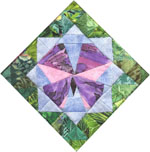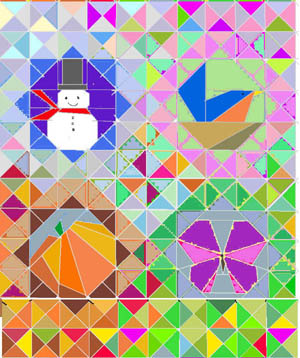Anna Grossnickle Hines Home Guide




Quilts in the Classroom
using the book, PIECES: A YEAR IN POEMS AND QUILTS
Designing With Half-square Triangles
Let's play with lines!
- Take a square. Draw a line to divide it half diagonally.
- What happens?
- Quilters call these triangles half-square triangles. They use them a lot.
- In PIECES three quilts use half-square triangles.
- Can you find them?
- Two use just a few half-square triangles, but one uses lots of them.
- It was fun to design with half-square triangles.
- There are so many possibilities! Want to try a few?
- Take two squares. Draw the lines to divide them in half diagonally.
- How many different ways can you put them together?
- Take four squares and divide them in half diagonally.
- Now how many ways can you put them together?
- Try this with 16 squares.
- How many different designs can you make?
- Try 25 squares.
- What happens? Do you run into any difficulties or limitations?
- Why?
- Try 36 squares.
- Now what happens?
- Isn't that interesting?
- Do you know about symmetry?
- When something is symmetrical, you can put a line through the center and both halves will be just the same.
- Actually the two halves will be exact opposites, or mirror images of one another.
- Can you think of anything else that is symmetrical?
- How about your body?
- Is your hand symmetrical?
- Nature uses lots of symmetry. Keep an eye open for examples.
- Can you make a symmetrical design with 8 half square triangle blocks?
- Can you make a square design?
- Can you make a symmetrical design with 9 half-square triangle blocks?
- Can you make a square design?
- What's the next number of half-square triangle blocks you need to make a symmetrical design?
- What's the next number you need to make a square design?
- Are designs using half-square triangles always symmetrical?
- Are symmetrical designs always square?
- What does it take to make a design that is both square and symmetrical?
- What happens if you use plain squares instead of triangle-squares?
- When a design is not symmetrical we call it asymmetrical.
- Can you make an asymmetrical design with 9 half-square triangle blocks?
- Can you do it with 4? ....16? ....36?
To download any of these files, click on the link, right click on the image, click on "Save Image As", then choose the folder where you want to save it. Open the file in any drawing and painting program, such as "Paint" in the Windows--Programs--Accessories folder. Use the line tool to draw diagonals in each square and the paint bucket to fill the spaces with color. Give the file another name when you save it and you can use it over and over again.





